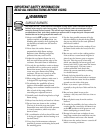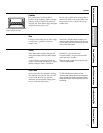
ge.com
Safety Instructions Operating Instructions Care and Cleaning Installation Instructions Troubleshooting Tips Consumer Support
READ AND FOLLOW THIS SAFETY INFORMATION CAREFULLY.
SAVE THESE INSTRUCTIONS
SURFACE BURNERS (cont.)
■ When a pilot goes out (on standing pilot
models), you will detect a faint odor of gas
as your signal to relight the pilot. When
relighting the pilot, make sure burner
controls are in the off position, and follow
instructions in this book to relight.
■ If you smell gas, and you have already
made sure pilots are lit (on standing pilot
models), turn off the gas to the range and
call a qualified service technician. Never
use an open flame to locate a leak.
■ Do not place or store items that can melt
or catch fire on the grates, even when the
cooktop is not being used.
■ Keep range clean and free of
accumulations of grease or spillovers,
which may ignite.
Do not locate the range where it may be subject to strong drafts. Any openings in the floor or wall
behind the range should be sealed. Make sure the openings around the base of the range that supply
fresh air for combustion and ventilation are not obstructed by carpeting or woodwork.
FLOORING UNDER THE RANGE
Your range, like many other household items,
is heavy and can settle into soft floor coverings
such as cushioned vinyl or carpeting. Use
care when moving the range on this type of
flooring. It is recommended that the following
simple and inexpensive instructions be
followed to protect your floor.
The range should be installed on a sheet of
plywood (or similar material). When the floor
covering ends at the front of the range, the
area that the range will rest on should be built
up with plywood to the same level or higher
than the floor covering.
This will allow the range to be moved for
cleaning or servicing. Also, make sure your
floor covering will withstand 180°F. (See the
Installation Safety Instructions section).
Make sure the wall coverings around your
range can withstand the heat generated (up to
200°F) by the range. (See the Installation
Safety Instructions section).
Leveling legs are located on each corner of
the base of the range. Your range must be
level in order to produce proper cooking and
baking results. After it is in its final location,
place a level horizontally on any oven shelf
and check the levelness front to back and
side to side. Level the range by adjusting the
leveling legs or by placing shims under the
corners as needed.
LEVELING THE RANGE
7


















